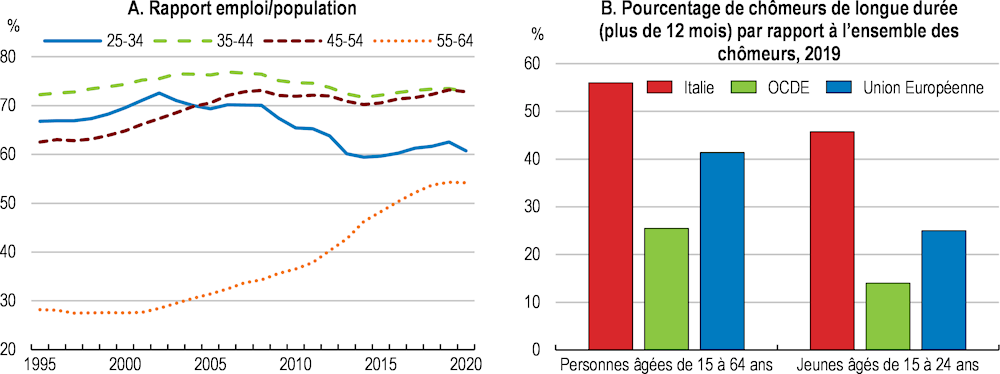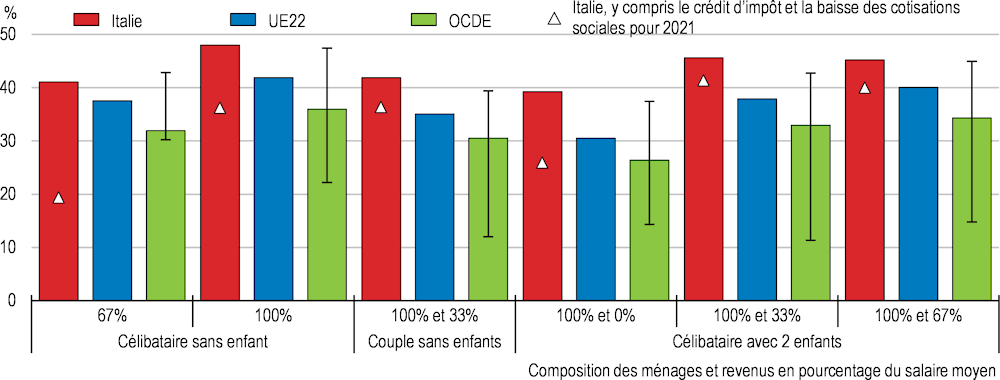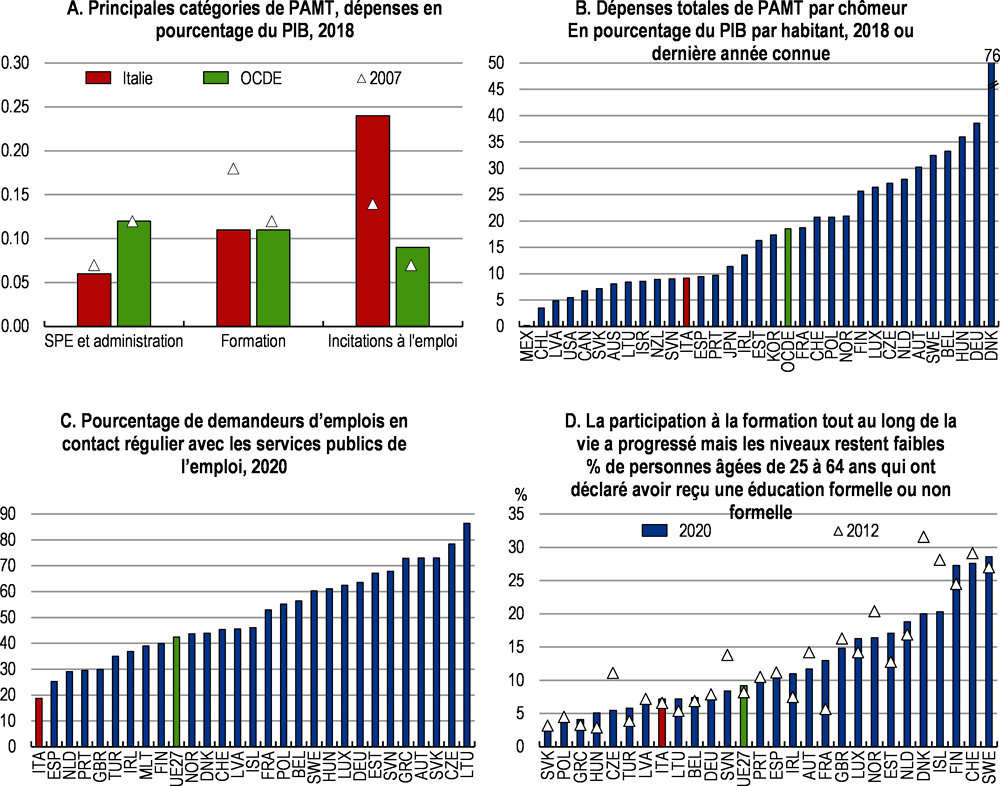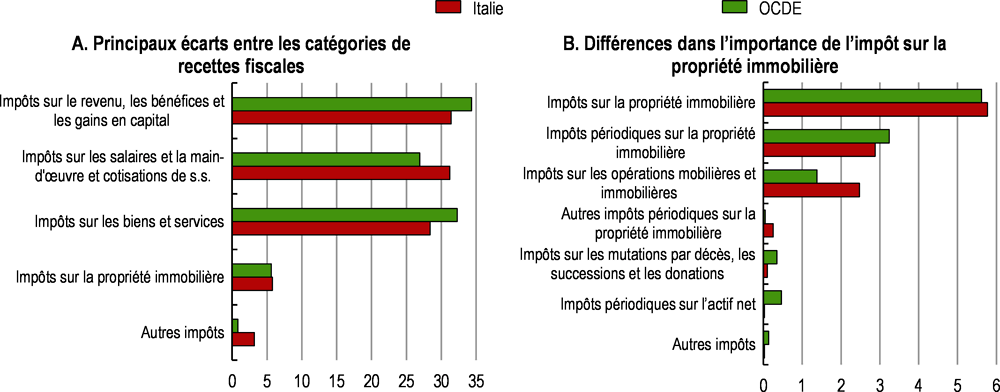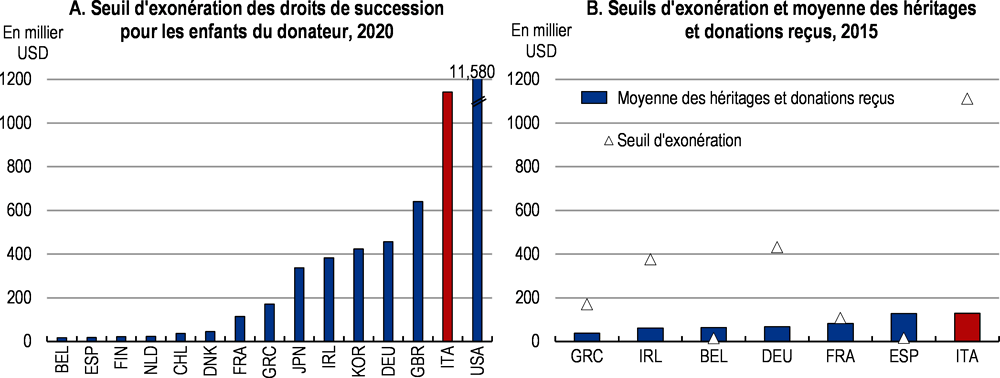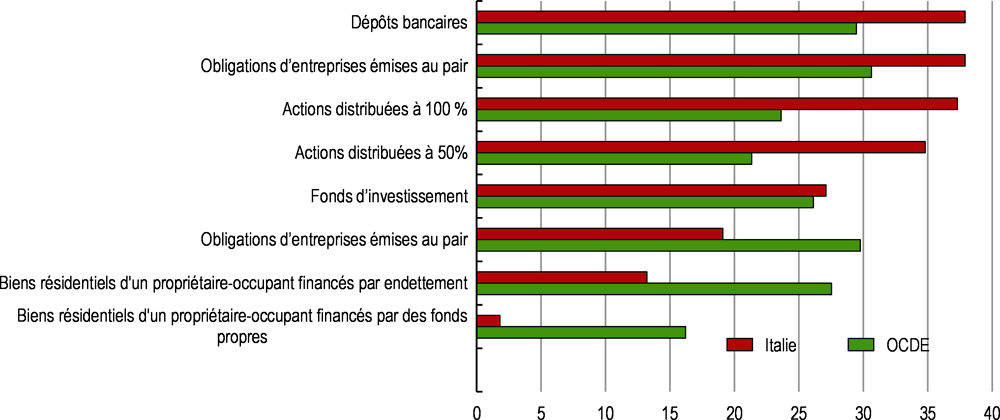[231] Accetturo, A. et G. de Blasio (2012), « Policies for local development: An evaluation of Italy’s “Patti Territoriali” », Regional Science and Urban Economics, vol. 42/1-2, https://doi.org/10.1016/j.regsciurbeco.2011.04.005.
[115] Acciari, P. et S. Morelli (2021), Wealth Transfers and Net Wealth at Death: Evidence from the Italian Inheritance Tax Records, https://www.nber.org/system/files/chapters/c14451/c14451.pdf (consulté le 15 juin 2021).
[15] Acharya, V. et al. (2019), « Whatever It Takes: The Real Effects of Unconventional Monetary Policy », American Historical Review, vol. 124/2, pp. 3366-3411, https://doi.org/10.1093/rfs/hhz005.
[230] Adalet McGowan, M., D. Andrews et V. Millot (2017), « Insolvency Regimes, Zombie Firms and Capital Reallocation », Documents de travail du Département des affaires économiques, n° 1399, OCDE, Paris, http://www.oecd.org/fr/eco/documentsdetravaildudepartementdesaffaireseconomiques.htm.
[50] Agence européenne pour l’environnement (2019), The European environment - state and outlook 2020: Knowledge for transition to a sustainable Europe, https://doi.org/10.2800/96749.
[229] Agenzia per la coesione territoriale (2018), Rapporto sui Tempi di Attuazione delle Opere Pubbliche, http://www.agenziacoesione.gov.it/it/Notizie_e_documenti/Focus/I_tempi_delle_opere_pubbliche/index. (consulté le 2 juin 2021).
[228] Agovino, M., M. Ferrara et A. Garofalo (2016), « An exploratory analysis on waste management in Italy: A focus on waste disposed in landfill », Land Use Policy, vol. 57, https://doi.org/10.1016/j.landusepol.2016.06.027.
[33] Albanese, G., G. Blasio et A. Locatelli (2021), « Does EU regional policy promote local TFP growth? Evidence from the Italian Mezzogiorno », Papers in Regional Science, vol. 100/2, https://doi.org/10.1111/pirs.12574.
[227] Albarea, A. et al. (2020), « Income Underreporting and Tax Evasion in Italy: Estimates and Distributional Effects », Review of Income and Wealth, vol. 66/4, pp. 904-930, https://doi.org/10.1111/roiw.12444.
[226] Allain-Dupré, D., C. Hulbert et M. Vincent (2017), « Subnational Infrastructure Investment in OECD Countries: Trends and Key Governance Levers », Documents de travail de l’OCDE sur le développement régional, n° 2017/05, Éditions OCDE, Paris, https://dx.doi.org/10.1787/e9077df7-en.
[225] Alsina Naudi, A. (2018), « Endeavours towards a plain legal language: The case of Spanish in context », International Journal of Legal Discourse, vol. 3/2, pp. 235-268, https://doi.org/10.1515/ijld-2018-2010.
[224] Amici, M. et al. (2015), « Red tape reduction and firm entry: evidence from an Italian reform », Occasional Papers, n° 285, Banca d’Italia, Rome, http://ssrn.com/abstract=2728301.
[223] Andini, M. et G. de Blasio (2016), « Local development that money cannot buy: Italy’s Contratti di Programma », Journal of Economic Geography, vol. 16/2, https://doi.org/10.1093/jeg/lbu048.
[47] Andrews, D., M. Adalet McGowan et V. Millot (2017), « Confronting the zombies: policies for productivity revival », Economic Policy Paper, n° 21, OCDE, Paris.
[65] Andrews, D., C. Criscuolo et N. Gal (2016), « The best versus the rest: the global productivity slowdown, divergence across firms and the role of public policy », Productivity Working Papers, n° 5, OCDE, Paris.
[76] Andrews, D., G. Nicoletti et C. Timiliotis (2018), « Digital technology diffusion: A matter of capabilities, incentives or both? », Documents de travail du Département des affaires économiques de l’OCDE, n° 1476, Éditions OCDE, Paris, https://dx.doi.org/10.1787/7c542c16-en.
[52] Anfia (2020), « The Italian automotive industry during 2019 », https://www.anfia.it/data/studi-e-statistiche/dati-statistici/settore-industriale/ANFIA-Report_Italian_Automotive_Industry_2019_DEF_ENG.pdf (consulté le 13 juin 2021).
[109] Arnold, J. et al. (2011), « Tax Policy for Economic Recovery and Growth », The Economic Journal, vol. 121/550, https://doi.org/10.1111/j.1468-0297.2010.02415.x.
[11] Arriola, C. et al. (2020), « The trade impact of the UK’s exit from the EU Single Market », Documents de travail du Département des affaires économiques de l’OCDE, n° 1631, Éditions OCDE, Paris, https://dx.doi.org/10.1787/682c2995-en.
[222] Artinger, F., S. Artinger et G. Gigerenzer (2018), « C. Y. A.: frequency and causes of defensive decisions in public administration », Business Research, vol. 12/1, pp. 9-25, https://doi.org/10.1007/s40685-018-0074-2.
[51] Association des constructeurs européens d’automobiles (2021), Average age of the EU vehicle fleet, by country, https://www.acea.auto/figure/average-age-of-eu-vehicle-fleet-by-country/ (consulté le 13 juin 2021).
[221] Attrey, A., C. Lesher et C. Lomax (2020), « The role of regulatory sandboxes in promoting flexibility and innovation in the digital age », Going Digital Policy Toolkit Policy Note, vol. 2, https://goingdigital.oecd.org/toolkitnotes/the-role-of-sandboxes-in-promoting-flexibility-and-innovation-in-the-digital-age.pdf.
[71] Bambalaite, I., G. Nicoletti et C. von Rueden (2020), « Occupational entry regulations and their effects on productivity in services: Firm-level evidence », Documents de travail du Département des affaires économiques de l’OCDE, n° 1605, Éditions OCDE, Paris, https://dx.doi.org/10.1787/c8b88d8b-en.
[36] Banca d’Italia (2021), Annual Report 2020, https://www.bancaditalia.it/pubblicazioni/relazione-annuale/2020/rel_2020.pdf (consulté le 4 juin 2021).
[5] Banca d’Italia (2021), « Credito e liquidità per famiglie e imprese », communiqué de presse, Banca d’Italia, Rome, https://www.bancaditalia.it/media/comunicati/documenti/2021-01/CS_Congiunto_TaskForce_24marzo2021.pdf (consulté le 13 avril 2021).
[12] Banca d’Italia (2021), « Financial Stability Report 2021 », vol. 1.
[219] Banca d’Italia (2020), « Rapporto sulla stabilità finanziaria », n° 2, Banca d’Italia, Rome, https://www.bancaditalia.it/pubblicazioni/rapporto-stabilita/2020-2/RSF_2_2020.pdf (consulté le 13 avril 2021).
[220] Banca d’Italia (s.d.), « Financial Stability Report (1) », 1, https://www.bancaditalia.it/pubblicazioni/rapporto-stabilita (consulté le 13 juin 2021).
[26] Banca d’Italia et al. (2021), « Credito e liquidità per famiglie e imprese », https://www.bancaditalia.it/media/comunicati/documenti/2021-01/cs_TaskForce_3giugno2021.pdf (consulté le 13 juin 2021).
[82] Banks, G. (2015), « Institutions to promote pro-productivity policies: Logic and lessons. », OECD Productivity Working Papers, n° 1.
[218] Banque européenne d’investissement (2017), Municipal Infrastructure: EIB Investment Survey, BEI, https://www.eib.org/attachments/efs/eibis_2017_municipality_en.pdf (consulté le 11 juin 2021).
[217] Banque mondiale (2020), Public sector wage premium (compared to all private employees) | Data Catalog, Banque mondiale, Washington, D.C., https://datacatalog.worldbank.org/public-sector-wage-premium-compared-all-private-employees (consulté le 19 avril 2021).
[239] Banque mondiale (s.d.), The Future of Business Regulation: Case Study: Promoting compliance – and going beyond, Groupe de la Banque mondiale.
[216] Bassanini, F. (2010), « Twenty years of administrative reform in Italy », Astrid Rassegna, vol. 4, http://www.astrid-online.it/static/upload/protected/Bass/Bassanini_Review_Economic_Conditions_Italy_3_09.pdf (consulté le 4 avril 2021).
[215] Battini, S. et F. Decarolis (2019), « L’amministrazione si difende », Rivista trimestrale di diritto pubblico, vol. 1, https://www.irpa.eu/articolo/lamministrazione-si-difende/ (consulté le 23 avril 2021).
[214] Bazzoli, M. et al. (2020), Size, heterogeneity and distributional effects of self-employment income tax evasion in Italy, http://irvapp.fbk.eu.
[63] Berestycki, C. et A. Dechezleprêtre (2020), « Assessing the efficiency of environmental policy design and evaluation: Results from a 2018 cross-country survey », Documents de travail du Département des affaires économiques de l’OCDE, n° 1161.
[211] Blanc, F. (2020), « Regulation, Regulatory Delivery, Trust and Distrust: Avoiding Vicious Circles », dans The crisis of confidence in legislation, Nomos Verlagsgesellschaft mbH & Co. KG, https://doi.org/10.5771/9783748907244-307.
[212] Blanc, F. (2012), Inspection Reforms: Why, how and what results, OCDE, https://www.oecd.org/regreform/Inspection%20reforms%20-%20web%20-F.%20Blanc.pdf (consulté le 24 février 2021).
[210] Blanc, F., C. Kauffman et M. Amaral (2020), Removing administrative barriers, improving regulatory delivery, http://www.oecd.org/coronavirus/policy-responses/removing-administrative-barriers-improving-regulatory-delivery-6704c8a1/.
[213] Blanc, F., G. Ottimofiore et A. Knutov (2019), « Comparative analysis of the legislative framework regulating inspection and supervision activities in the Russian Federation at the federal and municipal levels vis-à-vis international standards and good practices », Conseil de l’Europe, vol. Technical Paper ECCD-PRECOP II-TP-9/2018.
[278] Blöchliger, H. et J. Kim (dir. pub.) (2016), Fiscal Federalism 2016: Making Decentralisation Work, Éditions OCDE, Paris, https://dx.doi.org/10.1787/9789264254053-en.
[209] Blöndal, J., L. von Trapp et E. Hammer (2016), « Budgeting in Italy », OECD Journal on Budgeting, vol. 15/3, https://dx.doi.org/10.1787/budget-15-5jm0qg8kq1d2.
[208] Bobbio, E. (2016), « Tax evasion, firm dynamics and growth », Occasional Paper, n° 357, Banca d’Italia, Rome, https://www.bancaditalia.it/pubblicazioni/qef/2016-0357/QEF_357_16.pdf?language_id=1 (consulté le 13 avril 2021).
[207] Boeri, T. et S. Rizzo (2020), Riprendiamoci lo Stato. Come l’Italia può ripartire doi, Feltrinelli.
[206] Bonomi Savignon, A., L. Costumato et B. Marchese (2019), « Performance Budgeting in Context: An Analysis of Italian Central Administrations », Administrative Sciences, vol. 9/4, p. 79, https://doi.org/10.3390/admsci9040079.
[205] Bounds, G. (2012), Public Investment across Levels of Government: The Case of Victoria, Australia, OCDE, Paris, https://www.oecd.org/cfe/regionaldevelopment/victoria_edited.pdf (consulté le 23 avril 2021).
[204] Bova, E., R. Ercoli et X. Bosch (2020), « Spending Reviews: Some Insights from Practitioners », European Economy Discussion Papers, n° 135, Commission européenne, Bruxelles, https://doi.org/10.765/616187.
[203] Braiotta, A. et al. (2015), Tax gap and redistributive aspects across Italy, https://www.researchgate.net/publication/275949809.
[49] Branzoli, N. et A. Caiumi (2020), « How effective is an incremental ACE in addressing the debt bias? Evidence from corporate tax returns », International Tax and Public Finance, vol. 27/6, pp. 1485-1519, https://doi.org/10.1007/s10797-020-09609-2.
[119] Bratta, B. (2021), Reforming Tax Expenditures in Europe, https://www.cepweb.org/wp-content/uploads/2021/02/BRATTA-Italian-Tax-Expenditure-report-Feb21.pdf (consulté le 13 avril 2021).
[43] Bratta, B., L. Romano et P. Acciari (2020), The Impact of Digitalization Policies. Evidence from Italy’s Hyper-depreciation of Industry 4.0 Investments.
[41] Briguglio, D. et al. (2019), Private investment in Italy, Discussion paper n° 8, septembre 2019, https://ec.europa.eu/info/sites/info/files/economy-finance/dp108_en_private_invest_in_it.pdf (consulté le 5 mars 2021).
[202] Brosio, G. (2018), « Ambition beyond feasibility? Equalization transfers to regional and local governments in Italy », Documento de Trabajo, n° 2018/0, Université de Turin, Turin, https://documentos.fedea.net/pubs/dt/2018/dt2018-09.pdf (consulté le 14 avril 2021).
[96] Brunetti, I. et al. (2020), « Evaluating hiring incentives: Evidence from Italian firms Student evaluation of teachers View project », n° 52, INAPP - Istituto nazionale per l’analisi delle politiche pubbliche, https://www.researchgate.net/publication/344321436.
[17] Bruno, B. et E. Carletti (2021), « Moratoria sì, moratoria no in tempi di pandemia », https://www.lavoce.info/archives/72770/moratoria-si-moratoria-no-in-tempi-di-pandemia/.
[110] Brys, B. et al. (2016), « Tax Design for Inclusive Economic Growth », Documents de travail de l’OCDE sur la fiscalité,, n° 26.
[201] Brys, B. et al. (2016), « Tax Design for Inclusive Economic Growth », Documents de travail de l’OCDE sur la fiscalité, n° 26, Éditions OCDE, Paris, https://dx.doi.org/10.1787/5jlv74ggk0g7-en.
[66] Bugamelli, M. et al. (2018), « Productivity growth in Italy: a tale of a slow-motion change », Occasional Papers, n° 422, Banca d’Italia, Rome, http://www.bancaditalia.it.
[200] Bulman, T. et R. Doino (à paraître), « What helps Italian municipal governments effectively deliver public goods and services? An empirical investigation », vol. Technical Background Paper.
[97] Cahuc, P., S. Carcillo et T. Le Barbanchon (2019), « The effectiveness of hiring credits », Review of Economic Studies, vol. 86/2, pp. 593-626, https://doi.org/10.1093/restud/rdy011.
[199] Calligaris, S. et al. (2016), Italy’s Productivity Conundrum A Study on Resource Misallocation in Italy - discussion paper n° 030 | May 2016, https://doi.org/10.2765/970192.
[116] Cammeraat, E. et E. Crivelli (2020), Toward a Comprehensive Tax Reform for Italy Toward a Comprehensive Tax Reform for Italy 1 Prepared by Emile Cammeraat 2 and Ernesto Crivelli.
[18] Canino, I. et al. (2020), State of the art of the Italian liquidity measures-Keeping Italian Companies Alive?, White & Case, https://www.whitecase.com/sites/default/files/2020-07/COVID-19-Italian-Governmental-Support-for-Companies-200714.pdf (consulté le 13 juin 2021).
[6] Cantó Sánchez, O. et al. (2021), Welfare Resilience at the Onset of the COVID-19 Pandemic in a Selection of European Countries: Impact on Public Finance and Household Incomes.
[93] Cantone, R. et F. Caringella (2017), La corruzione spuzza. Milan: Mondadori, Mondadori, Milan.
[198] Card, D., J. Kluve et A. Weber (2017), « What Works? A Meta Analysis of Recent Active Labor Market Program Evaluations », Journal of the European Economic Association, vol. 16/3, pp. 894-931, https://doi.org/10.1093/jeea/jvx028.
[94] Carelli, D. (2019), « The Focal Power of Anticorruption Law: Insights from Italian State-Building ».
[197] Carta, F. (2019), « Female labour supply in Italy: the role of parental leave and child care policies », Questioni di Economia e Finanza, n° 539, Banca d’Italia, Rome, https://www.bancaditalia.it/pubblicazioni/qef/2019-0539/QEF_539_19.pdf?language_id=1 (consulté le 12 avril 2021).
[196] Cavalleri, E. (2017), A revised approach to trend employment projections in long-term scenarios, OCDE, Paris, http://www.oecd.org/eco/workingpapers.
[29] Cavalleri, M. et Y. Guillemette (2017), « A revised approach to trend employment projections in long-term scenarios », Documents de travail du Département des affaires économiques de l’OCDE, n° 1384, Éditions OCDE, Paris.
[195] Cavatorto, S. et A. La Spina (2020), The Politics of Public Administration Reform in Italy, Springer International Publishing, Cham, https://doi.org/10.1007/978-3-030-32288-5.
[85] CERVED (2020), « Fallimenti, pecedure e chiusura dímpresa », Osservatorio, n° 42 (3Q), CERVED, https://know.cerved.com/wp-content/uploads/2020/12/Osservatorio-fallimenti-procedure-e-chiusure-di-impresa_3q2020-1.pdf (consulté le 13 avril 2021).
[58] Cialani, C. et R. Mortazavi (2020), « The Cost of Urban Waste Management: An Empirical Analysis of Recycling Patterns in Italy », Frontiers in Sustainable Cities, vol. 2, https://doi.org/10.3389/frsc.2020.00008.
[194] Ciani, E. et G. de Blasio (2015), « European structural funds during the crisis: evidence from Southern Italy », IZA Journal of Labor Policy, vol. 4/1, https://doi.org/10.1186/s40173-015-0047-4.
[42] Ciapanna, E., S. Mocetti et A. Notarpietro (2020), The effects of structural reforms: Evidence from Italy.
[25] Comité européen du risque systémique (2021), Italy: Measures taken in response to coronavirus (COVID-19) pandemic, https://www.esrb.europa.eu/home/search/coronavirus/countries/html/esrb.covidpmc_Italy.en.html (consulté le 13 avril 2021).
[37] Commission européenne (2021), « Analysis of the recovery and resilience plan of Italy », document de travail des services de la Commission, n° SWD(2021) 165, https://ec.europa.eu/info/system/files/com-2021-344_swd_en.pdf (consulté le 24 juin 2021).
[21] Commission européenne (2021), « Debt Sustainability Monitor 2020 », Institutional Papers, n° 143, https://doi.org/10.2765/862465.
[191] Commission européenne (2021), Italy - Early Childhood Education and Care, Eurydice, https://eacea.ec.europa.eu/national-policies/eurydice/content/early-childhood-education-and-care-39_en (consulté le 14 avril 2021).
[190] Commission européenne (2021), « Rapport sur l’instrument européen de soutien temporaire à l’atténuation des risques de chômage en situation d’urgence (SURE) engendrée par la propagation de la COVID-19 conformément à l’article 14 du règlement (UE) 2020/672 du Conseil - SURE: inventaire après six mois », COM, n° 148, https://op.europa.eu/en/publication-detail/-/publication/5e136d5f-8b09-11eb-b85c-01aa75ed71a1/language-en (consulté le 23 avril 2021).
[24] Commission européenne (2021), « The 2021 Ageing Report. Economic and Budgetary Projections for the EU Member States (2019-2070), Bruxelles. », https://doi.org/10.2765/84455.
[90] Commission européenne (2020), « 2020 Rule of Law Report Country Chapter on the rule of law situation in Italy », document de travail des services de la Commission, Commission européenne.
[193] Commission européenne (2020), « Assessment of the final national energy and climate plan of Italy », document de travail des services de la Commission, n° 911, https://ec.europa.eu/energy/sites/ener/files/documents/staff_working_document_assessment_necp_italy.pdf (consulté le 13 avril 2021).
[14] Commission européenne (2020), « Country Report Italy 2020 », document de travail des services de la Commission, Commission européenne, Bruxelles.
[287] Commission européenne (2020), Country Report Italy 2020, Commission européenne, https://eur-lex.europa.eu/legal-content/EN/TXT/PDF/?uri=CELEX:52020SC0511&from=EN.
[8] Commission européenne (2020), « Educational inequalities in Europe and physical school closures during Covid-19 », Fairness Policy Briefs Series, n° 4, Commission européenne, Bruxelles, https://ec.europa.eu/jrc/en/research/crosscutting-activities/fairness.
[84] Commission européenne (2019), « Rapport sur les progrès accomplis dans la mise en œuvre de la recommandation du Conseil du 20 septembre 2016 sur la création de conseils nationaux de la productivité », Rapport de la Commission au Conseil, n° 152, https://eur-lex.europa.eu/resource.html?uri=cellar:be796da7-3b67-11e9-8d04-01aa75ed71a1.0006.02/DOC_1&format=PDF (consulté le 15 juin 2021).
[192] Commission européenne (2019), Clear writing for Europe 2019 - Conference Notes, https://ec.europa.eu/info/events/CWC2019_en (consulté le 10 février 2021).
[189] Commission européenne (2018), The 2018 Ageing Report: Economic and Budgetary Projections for the EU Member States (2016-2070), https://doi.org/10.765/615631.
[75] Commission européenne (2017), Italy - Review of progress on policy measures relevant for the correction of macroeconomic imbalances, https://ec.europa.eu/info/sites/default/files/economy-finance/italy_sm_published_07032018.pdf (consulté le 15 juin 2021).
[243] Commission européenne (2016), Stock-taking of administrative capacity, systems and practices across the EU to ensure the compliance and quality of public procurement involving European Structural and Investment (ESI) Funds, Commission européenne, https://op.europa.eu/en/publication-detail/-/publication/d1082259-0202-11e6-b713-01aa75ed71a1.
[188] Commission européenne/EACEA/Eurydice (2019), Chiffres clés de l’éducation et de l’accueil des jeunes enfants en Europe : Édition 2019, Commission européenne, Luxembourg, https://doi.org/10.2797/966808.
[88] Conseil de l’Europe (2020), European judicial systems - CEPEJ Evaluation Report 2020: Evaluation cycle (2018 data), Conseil de l’Europe, https://rm.coe.int/evaluation-report-part-1-english/16809fc058 (consulté le 14 juin 2021).
[187] Conseil des ministres (2021), Piano nazionale di ripresa e resilienza, https://www.governo.it/sites/new.governo.it/files/PNRR_2021_0.pdf (consulté le 13 avril 2021).
[31] Conseil des ministres (2021), Piano Nazionale di Ripresa e Resilienza.
[81] Conseil européen (2016), « Recommandation du Conseil du 20 septembre 2016 sur la création de conseils nationaux de la productivité », Journal officiel de l’Union européenne, n° C 349/01.
[39] Crescenzi, R., M. Giua et G. Sonzogno (2021), « Mind the Covid-19 crisis: An evidence-based implementation of Next Generation EU », Journal of Policy Modeling, vol. 43/2, https://doi.org/10.1016/j.jpolmod.2021.03.002.
[99] Dares (2021), « Quels ont été les effets de l’aide à l’embauche des jeunes sur l’emploi des jeunes ? », Analyses, n° 22.
[40] Darvas, Z. (2020), Will European Union countries be able to absorb and spend well the bloc’s recovery funding?, Bruegel Blog, https://www.bruegel.org/2020/09/will-european-union-countries-be-able-to-absorb-and-spend-well-the-blocs-recovery-funding/ (consulté le 13 avril 2021).
[186] Davidson, P., C. Kauffmann et M. de Liedekerke (2021), « How do laws and regulations affect competitiveness: The role for regulatory impact assessment », OECD Regulatory Policy Working Papers, n° 15, Éditions OCDE, Paris, https://dx.doi.org/10.1787/7c11f5d5-en.
[185] De La Cruz, A., A. Medina et Y. Tang (2019), Owners of the World’s Listed Companies, OCDE, http://www.oecd.org/corporate/Owners-of-the-Worlds-Listed-Companies.htm.
[184] de Mooij, R. et M. Devereux (2011), « An applied analysis of ACE and CBIT reforms in the EU », International Tax and Public Finance, vol. 18/1, pp. 93-120, https://doi.org/10.1007/s10797-010-9138-8.
[183] De Mooij, R. et S. Hebous (2017), « Curbing Corporate Debt Bias: Do Limitations to Interest Deductibility Work? », Working Papers, n° WP/17/22, FMI, Washington, https://www.imf.org/en/Publications/WP/Issues/2017/01/30/Curbing-Corporate-Debt-Bias-44605 (consulté le 13 avril 2021).
[182] Deloitte (2021), La semplificazione amministrativa Come migliorare il rapporto tra PA e imprese, Deloitte, Milan, https://www2.deloitte.com/content/dam/Deloitte/it/Documents/public-sector/LaSemplificazioneAmministrativa_Deloitte.pdf (consulté le 23 avril 2021).
[10] Demmou, L. et al. (2021), « Insolvency and debt overhang following the COVID-19 outbreak: assessment of risks and policy responses », Documents de travail du Département des affaires économiques de l’OCDE, n° 1651, Éditions OCDE, Paris, https://dx.doi.org/10.1787/747a8226-en.
[181] Depalo, D., R. Giordano et E. Papapetrou (2015), « Public–private wage differentials in euro-area countries: evidence from quantile decomposition analysis », Empirical Economics, vol. 49/3, pp. 985-1015, https://doi.org/10.1007/s00181-014-0900-0.
[180] di Giuseppe, F., L. Landi et P. Lattarulo (2020), Il procurement dei lavori pubblici alla luce delle recenti riforme, Ufficio parlamentare di bilancio, https://en.upbilancio.it/wp-content/uploads/2020/06/Nota-appalti-2_2020.pdf.
[20] Dipartimento del Tesoro (2021), Weighted Average Life of Government Debt, http://www.dt.mef.gov.it/en/debito_pubblico/dati_statistici/vita_media_ponderata/index.html?selezione-anno=2014#selezione-anno (consulté le 13 avril 2021).
[179] Dougherty, S. et K. Forman (2021), « Evaluating fiscal equalisation: Finding the right balance », OECD Working Papers on Fiscal Federalism, n° 36, Éditions OCDE, Paris, https://dx.doi.org/10.1787/253da2b8-en.
[178] Downes, R., D. Moretti et S. Nicol (2017), « Budgeting and performance in the European Union: A review by the OECD in the context of EU budget focused on results », OECD Journal on Budgeting, vol. 17/1, https://dx.doi.org/10.1787/budget-17-5jfnx7fj38r2.
[177] Education and Employment References Committee (2018), Jobactive: Failing those it is intended to serve, The Senate, Commonwealth of Australia, https://parlinfo.aph.gov.au/parlInfo/download/committees/reportsen/024217/toc_pdf/Jobactivefailingthoseitisintendedtoserve.pdf;fileType=application%2Fpdf (consulté le 27 février 2020).
[176] Ehrenberg-Sundi, B. (s.d.), Plain Language in Sweden, the Results After 30 Years, plainlanguage.gov, https://www.plainlanguage.gov/resources/articles/plain-language-in-sweden/ (consulté le 10 février 2021).
[175] Fadic, M., P. Garda et M. Pisu (2019), « The effect of public sector efficiency on firm-level productivity growth: The Italian case », Documents de travail du Département des affaires économiques de l’OCDE, n° 1573, Éditions OCDE, Paris, https://dx.doi.org/10.1787/6d20b56d-en.
[60] Faiella, I. et L. Lavecchia (2021), « Households’ energy demand and the effects of carbon pricing in Italy », Questioni di Economia e Finanza (Occasional Papers), n° 614, Banca d’Italia, Rome, https://www.bancaditalia.it/pubblicazioni/qef/2021-0614/QEF_614_21.pdf (consulté le 13 juin 2021).
[102] Ferragina, E. (2020), « Family policy and women’s employment outcomes in 45 high-income countries: A systematic qualitative review of 238 comparative and national studies », Social Policy and Administration, vol. 54/7, pp. 1016-1066, https://doi.org/10.1111/spol.12584.
[174] Fertig, M. et N. Ziminiene (2017), PES Network Benchlearning Manual, Commission européenne, https://doi.org/10.2767/254654.
[173] Figari, F. et E. Narazani (2019), « The joint decision of female labour supply and childcare in Italy under costs and availability constraints », Economia Politica, vol. 37/2, pp. 411-439, https://doi.org/10.1007/s40888-019-00160-w.
[289] ForumPA (2017), Burocrazia difensiva. Come ne usciamo? Una ricerca di FPA, Forumpa, https://www.forumpa.it/riforma-pa/burocrazia-difensiva-come-ne-usciamo-una-ricerca-di-fpa/ (consulté le 22 avril 2021).
[54] G20 peer review teams (2019), Italy’s effort to phase out and rationalise its fossil-fuel subsidies: A report on the G20 peer-review of inefficient fossil-fuel subsidies that encourage wasteful consumption in Italy.
[172] Gallone, E. et al. (2020), « The 2017 deregulation of pharmacies in Italy: Introducing non-pharmacist ownership », Health Policy, vol. 124/12, pp. 1281-1286, https://doi.org/10.1016/j.healthpol.2020.08.013.
[77] Gal, P. et al. (2019), « Digitalisation and productivity: In search of the holy grail – Firm-level empirical evidence from EU countries », Documents de travail du Département des affaires économiques de l’OCDE, n° 1533, Éditions OCDE, Paris.
[171] Gerson, D. (2020), « Leadership pour une haute fonction publique performante : Vers un système de haute fonction publique dans les pays de l’OCDE », Documents de travail de l’OCDE sur la gouvernance publique, n° 40, Éditions OCDE, Paris, https://doi.org/10.1787/f87e7397-fr.
[56] Ghisellini, P. et S. Ulgiati (2020), « Circular economy transition in Italy. Achievements, perspectives and constraints », Journal of Cleaner Production, vol. 243, https://doi.org/10.1016/j.jclepro.2019.118360.
[68] Giordano, C., G. Toniolo et F. Zollino (2017), « Long-run trends in Italian productivity », Occasional Papers, n° 406, Banca d’Italia, Rome.
[170] Giua, M. (2017), « Spatial discontinuity for the impact assessment of the EU regional policy: the case of Italian objective 1 regions », Journal of Regional Science, vol. 57/1, https://doi.org/10.1111/jors.12300.
[272] Global Infrastructure Hub (2019), Leading Practices in Governmental Processes Facilitating Infrastructure Project Preparation, https://cdn.gihub.org/umbraco/media/2344/gih_project-preparation_full-document_final_art_web.pdf.
[169] Gourinchas, P. et al. (2020), « COVID-19 and SME Failures », Working Paper, n° 27877, NBER, Cambridge, Massachusetts, https://www.nber.org/system/files/working_papers/w27877/w27877.pdf (consulté le 13 avril 2021).
[168] Guillemette, D. (2021), The long game: fiscal outlooks to 2060 underline need for structural reform, OCDE.
[166] Guillemette, E. (2018), Saving, Investment, Capital Stock and Current Account Projections in Long-Term Scenarios, OCDE.
[167] Guillemette, E. (2017), A revised approach to productivity convergence in long-term scenarios, OCDE.
[30] Guillemette, Y., A. De Mauro et D. Turner (2018), « Saving, investment, capital stock and current account projections in long-term scenarios », Documents de travail du Département des affaires économiques de l’OCDE, n° 1461, Éditions OCDE, Paris.
[28] Guillemette, Y. et al. (2017), « A revised approach to productivity convergence in long-term scenarios », Documents de travail du Département des affaires économiques de l’OCDE, n° 1385, Éditions OCDE, Paris.
[38] Guillemette, Y. et D. Turner (2021), « The long game: fiscal outlooks to 2060 underline need for structural reform », Documents de travail du Département des affaires économiques de l’OCDE (à paraître), Éditions OCDE, Paris.
[27] Guillemette, Y. et D. Turner (2018), « The Long View: Scenarios for the World Economy to 2060 », OECD Economic Policy Papers, n° 22, Éditions OCDE, Paris, https://www.oecd-ilibrary.org/economics/the-long-view_b4f4e03e-en?_ga=2.18989688.1943566575.1623590112-1594724912.1617704849 (consulté le 14 juin 2021).
[55] Hall, D. et N. Lutsey (2020), Electric vehicle charging guide for cities C4O CITIES, http://www.theicct.org.
[164] Huerta Melchor, O. (2008), « La gestion du changement dans l’administration des pays de l’OCDE : Un premier aperçu général », Documents de travail de l’OCDE sur la gouvernance publique, n° 12, Éditions OCDE, Paris, https://doi.org/10.1787/227138426766.
[163] Hyee, R. et al. (2020), The OECD Tax-Benefit Model for Italy: Description of policy rules for 2020, OCDE, Paris, https://www.oecd.org/els/soc/TaxBEN-Italy-2020.pdf (consulté le 12 avril 2021).
[162] ICON-INSTITUT Public Sector (2018), Assessment Report on PES Capacity, European Network of Public Employment Services (Ad Hoc Module to the 2018 PES Capacity Questionnaire Survey report), Commission européenne, Bruxelles, https://ec.europa.eu/social/BlobServlet?docId=20575&langId=en.
[3] INPS (2021), CIG: i dati INPS aggiornati al 31 marzo 2021, https://www.inps.it/docallegatiNP/Mig/AllegatiNews/Accessibile_dati_CIG_31_marzo.pdf (consulté le 13 avril 2021).
[277] Institute of Public Management and Economic Development (2011), Generation Y and Public Management: Issues and Implications, Ministrère de l’Économie, https://https://www.economie.gouv.fr/files/pmo_38.pdf/files/pmo_38.pdf.
[9] ISTAT (2020), Il numero di pubblica utilita 1522 durante la pandemia (periodo Marzo-Ottobre 2020), https://www.istat.it/it/archivio/250804 (consulté le 13 avril 2021).
[101] ISTAT (2020), Nidi e servizi educativi per l’infanzia, https://www.istat.it/it/files/2020/06/report-infanzia_def.pdf (consulté le 15 juin 2021).
[4] ISTAT (2020), « Situazione e prospettive delle imprese nellémergenza sanitaria COVID-19 », Statistiche Report, Istat, Rome, https://www.istat.it/it/files//2020/12/REPORT-COVID-IMPRESE-DICEMBRE.pdf (consulté le 13 avril 2021).
[44] ISTAT (2018), « Ricerca e sviluppo in Italia 2016-2018 », Statistiche Report, https://www.istat.it/it/files/2018/09/Report-Ricerca-e-sviluppo_Anni-2016_2018.pdf (consulté le 13 avril 2021).
[161] Istat (2020), Le Partecipate Pubbliche in Italia: 2018, Istat, Rome, https://www.istat.it/it/archivio/252150#:~:text=Le%20unit%C3%A0%20economiche%20partecipate%20dal,amministrazione%20pubblica%20regionale%20o%20locale. (consulté le 5 mars 2021).
[160] Istat (2020), Local public administrations and ICT: 2018, Istat, Rome, https://www.istat.it/it/files//2020/05/LocalPA_and_ICT.pdf (consulté le 22 mars 2021).
[240] Istat (2019), Supply of Services for the Early Childhood Education: School Year 2017/2018, Istat, Rome, https://www.istat.it/it/files//2020/04/REPORT_asili-nido_EN.pdf (consulté le 8 avril 2021).
[159] Johansson, Å. (2008), « Taxation and Economic Growth », Documents de travail du Département des Affaires économiques de l’OCDE, n ° 620, Éditions OCDE, Paris, https://doi.org/10.1787/241216205486.
[158] Johansson, Å. et al. (2008), Taxation and Economic Growth.
[157] Karantounias, V. et D. Pinelli (2016), « Local State-Owned Enterprises in Italy: Inefficiencies and Ways Forward », Economic Brief, n° 010, https://doi.org/10.765/266052.
[156] Keller, A. (2018), « 2018 OECD Performance Budgeting Survey: Key findings and trends », Présentation, 14ème réunion annuelle du Réseau des hauts responsables du budget de l’OCDE sur la performance et les résultats, https://www.slideshare.net/OECD-GOV/international-trends-in-performance-budgeting-anne-keller-oecd.
[155] Lisciandra, M. et E. Millemaci (2015), « The Economic Effect of Corruption in Italy: A Regional Panel Analysis », Regional Studies, vol. 51/9, pp. 1387-1398, https://doi.org/10.2139/ssrn.2568136.
[154] Lorenzani, D. et V. Reitano (2015), « Italy’s Spending Maze Runner: An analysis of the structure and evolution of public expenditure in Italy », European Economy Discussion Papers, n° 23, Commission européenne, Bruxelles, https://doi.org/10.765/296530.
[67] Lotti, F. et E. Sette (2019), « Frontier and superstar firms in Italy », Occasional papers, n° 537, Banca d’Italia, Rome.
[91] Maggio, P. (2020), « A critical analysis of corruption and anti-corruption policies in Italy », Journal of Financial Crime, https://doi.org/10.1108/JFC-12-2019-0168.
[98] Martin, P. et R. Rathelot (2021), « Évaluation de l’aide à l’embauche des jeunes à partir des déclarations préalables à l’embauche », Focus, n° 060‐2021, https://www.cae-eco.fr/staticfiles/pdf/cae-focus060.pdf (consulté le 15 juin 2021).
[153] Matheson, A. et al. (2007), « Étude sur la participation politique aux décisions relatives à la nomination des hauts fonctionnaires et sur la délimitation des responsabilités entre ministres et hauts fonctionnaires », Documents de travail de l’OCDE sur la gouvernance publique, n° 6, Éditions OCDE, Paris, https://doi.org/10.1787/111168253630.
[152] MEF tax expenditures (2020), Commissione per le spese fiscali.
[151] Ministère de l’administration publique (2020), Semplificazione per la Ripesa: Agenda 2020-2023, http://www.italiasemplice.gov.it/media/2635/agenda_semplificazione_2020-2023.pdf (consulté le 1 mars 2021).
[19] Ministère de l’Économie et des Finances (2021), « Documento di Economia e Finanza », Sezione 1, Programma di Stabilita.
[22] Ministère de l’Économie et des Finances (2020), Documento programmatico di bilancio 2021.
[150] Ministère de l’Économie et des Finances (2020), « Mid/ Long-term trends for the pension, health and long-term care systems: Projections of the State General Accounting Department », n° 21 (update), Ragioneria Generale dello Stato, Rome, https://www.rgs.mef.gov.it/_Documenti/ENGLISH-VE/Institutio/Social-exp/Forcast-ac/Rapporto-n.-21-Nota-Aggiornamento-ENG-22122020.pdf (consulté le 13 avril 2021).
[117] Ministère de l’Économie et des Finances (2020), Rapporto annuale sulle spese fiscali 2020, https://www.mef.gov.it/documenti-allegati/2021/Rapporto-spese-fiscali-nov-2020.pdf (consulté le 14 juin 2021).
[250] Ministère de l’Économie et des Finances (2020), Rapporto sugli esiti della revisione straordinaria delle partecipazioni pubbliche, Ministère de l’Économie et des Finances, Dipartimento del Telsoro, http://www.dt.mef.gov.it/export/sites/sitodt/modules/documenti_it/programmi_cartolarizzazione/patrimonio_pa/Rapporto_sugli_esiti_della_Revisione_straordinaria_DEF_maggio_2019.pdf (consulté le 5 mars 2021).
[113] Ministère de l’Économie et des Finances (2020), « Relazione sull’economia non osservata e sull’evasione fiscale e contributive ».
[78] Ministère de l’Innovation et de la Transition numérique et Ministère du Développement économique (2021), Strategia Italiana per la Banda Ultralarga « Verso la Gigabit Society », https://assets.innovazione.gov.it/1622021525-strategia-bul.pdf (consulté le 13 juin 2021).
[149] Ministère de la Justice (2021), « Relazione del Ministro sull’amministrazione della giustizia per l’anno 2020, ai sensi dell’art. 86, R.D. 30 gennaio 1941, n° 12 ».
[87] Ministère de la Justice (2020), Statistiques fournies par les autorités.
[256] Ministère de la Justice, Suède (2006), Plain Legal Language: Sweden’s approach to clearly written laws, https://www.oecd.org/mena/governance/37788778.pdf (consulté le 10 février 2021).
[61] Ministère des Finances, S. (2018), Lessons Learned from 25 Years of Carbon Taxation in Sweden, https://www.government.se/48e9fb/contentassets/18ed243e60ca4b7fa05b36804ec64beb/lessons-learned-from-25-years-of-carbon-taxation-in-sweden.pdf#mce_temp_url (consulté le 13 juin 2021).
[74] Mocetti, S., L. Rizzica et G. Roma (2019), « Regulated occupations in Italy: Extent and labor market effects », Occasional Papers, n° 495, Banca d’Italia, Rome, https://www.bancaditalia.it/pubblicazioni/qef/2019-0495/QEF_495_19.pdf?language_id=1 (consulté le 13 avril 2021).
[148] Montén, A. et C. Thater (2011), « Determinants of Efficiency in Child-Care Provision », FinanzArchiv, vol. 67/4, p. 378, https://doi.org/10.1628/001522111x614178.
[147] Murtin, F. et al. (2018), « Trust and its determinants: Evidence from the Trustlab experiment », OECD Statistics Working Papers, n° 2018/2, Éditions OCDE, Paris, https://dx.doi.org/10.1787/869ef2ec-en.
[92] Nations Unies (2018), Review of implementation of the United Nations Convention against Corruption Executive summary: Italy.
[105] Nedelkoska, L. et G. Quintini (2018), Automation, skills use and training, https://www.oecd-ilibrary.org/employment/automation-skills-use-and-training_2e2f4eea-en (consulté le 13 juin 2021).
[146] Nicoletti, G. et al. (2021), « Spurring growth and closing gaps through digitalisation: policies to LIFT all boats », Groupe de travail n° 1 chargé de l’analyse des politiques macro-économiques et structurelles, vol. ECO/CPE/WP1(2021)13.
[145] Noman, Z. (2008), « Performance budgeting in the United Kingdom », OECD Journal on Budgeting, vol. 8/1, https://dx.doi.org/10.1787/budget-v8-art4-en.
[254] NZ Productivity Commission (2013), « Primer on local government coordination: online appendix to the inquiry into local government regulatory performance », https://www.productivity.govt.nz/assets/Documents/6aa777749b/Online-appendix-Primer-on-local-government-coordination.pdf.
[111] OCDE (2021), Impôt sur les successions dans les pays de l’OCDE, Études de politique fiscale de l’OCDE, n° 28, Éditions OCDE, Paris, https://doi.org/10.1787/33d40568-fr.
[263] OCDE (2021), OECD Economic Surveys: Spain 2021, Éditions OCDE, Paris, https://dx.doi.org/10.1787/79e92d88-en.
[45] OCDE (2021), OECD Science, Technology and Innovation Outlook 2021: Times of Crisis and Opportunity, Éditions OCDE, Paris, https://doi.org/10.1787/75f79015-en.
[258] OCDE (2021), Perspectives économiques de l’OCDE, Rapport intermédiaire, mars 2021, Éditions OCDE, Paris, https://dx.doi.org/10.1787/01954fa3-fr.
[13] OCDE (2021), Perspectives économiques de l’OCDE, Volume 2021 Numéro 1, Éditions OCDE, Paris, https://dx.doi.org/10.1787/631c1b44-fr.
[107] OCDE (2021), « Raising skills in SMES in the digital transformation: A review of policy instruments in Italy (à paraître) ».
[141] OCDE (2021), Supporting jobs and companies: A bridge to the recovery phase.
[237] OCDE (2021), « The OECD Framework for digital talent and skills in the public sector », Documents de travail de l’OCDE sur la gouvernance publique, n° 45, Éditions OCDE, Paris, https://dx.doi.org/10.1787/4e7c3f58-en.
[238] OCDE (2021), « The OECD Framework for digital talent and skills in the public sector », Documents de travail de l’OCDE sur la gouvernance publique, Organisation de coopération et de développement économiques (OCDE), https://doi.org/10.1787/4e7c3f58-en.
[143] OCDE (2020), « Annual Report on Competition Policy Developments in Italy », Comité de la concurrence de la Direction des affaires financières et des entreprises, n° 17, OCDE, Paris, https://one.oecd.org/document/DAF/COMP/AR(2020)17/en/pdf (consulté le 13 avril 2021).
[281] OCDE (2020), Examiner la réglementation existante, Principes de bonne pratique de l’OCDE en matière de politique réglementaire, Éditions OCDE, Paris, https://doi.org/10.1787/eb656b8d-fr.
[280] OCDE (2020), Financing SMEs and Entrepreneurs 2020: An OECD Scoreboard, Éditions OCDE, Paris, https://doi.org/10.1787/061fe03d-en.
[275] OCDE (2020), Governance for Youth, Trust and Intergenerational Justice: Fit for All Generations?, Examens de l’OCDE sur la gouvernance publique, Éditions OCDE, Paris, https://dx.doi.org/10.1787/c3e5cb8a-en.
[59] OCDE (2020), Green budgeting and tax policy tools to support a green recovery, Éditions OCDE, https://doi.org/10.1787/bd02ea23-en (consulté le 13 juin 2021).
[108] OCDE (2020), Increasing Adult Learning Participation: Learning from Successful Reforms, Getting Skills Right, Éditions OCDE, Paris, https://dx.doi.org/10.1787/cf5d9c21-en.
[273] OCDE (2020), Integrating Responsible Business Conduct in Public Procurement, Éditions OCDE, Paris, https://dx.doi.org/10.1787/02682b01-en.
[69] OCDE (2020), « Italy: Business Dynamics », Insights on Productivity and Business Dynamics, OCDE, Paris, https://www.oecd.org/sti/ind/oecd-business-dynamics-insights-italy.pdf (consulté le 13 avril 2021).
[269] OCDE (2020), OECD Capital Market Review of Italy 2020: Creating Growth Opportunities for Italian Companies and Savers, OCDE, http://www.oecd.org/corporate/OECD-Capital-Market-Review-Italy.htm.
[48] OCDE (2020), OECD Capital Markets Review: Creating Growth Opportunities for Italian Companies and Savers.
[268] OCDE (2020), OECD Economic Surveys: Germany 2020, Éditions OCDE, Paris, https://dx.doi.org/10.1787/91973c69-en.
[114] OCDE (2020), Tendances des impôts sur la consommation 2020 : TVA/TPS et droits d’accises – taux, tendances et questions stratégiques, Éditions OCDE, Paris, https://dx.doi.org/10.1787/3f06ea4d-fr.
[106] OCDE (2019), Adult Learning in Italy: What Role for Training Funds ?, Getting Skills Right, Éditions OCDE, Paris, https://dx.doi.org/10.1787/9789264311978-en.
[292] OCDE (2019), Better Regulation Practices across the European Union, Éditions OCDE, Paris, https://dx.doi.org/10.1787/9789264311732-en.
[73] OCDE (2019), « Les barrières à la sortie », OCDE, Paris, https://one.oecd.org/document/DAF/COMP(2019)15/fr/pdf (consulté le 13 avril 2021).
[53] OCDE (2019), OECD Economic Surveys: Italy 2019, Éditions OCDE, Paris, https://doi.org/10.1787/369ec0f2-en.
[264] OCDE (2019), OECD Economic Surveys: New Zealand 2019, Éditions OCDE, Paris, https://dx.doi.org/10.1787/b0b94dbd-en.
[262] OCDE (2019), OECD Good Practices for Performance Budgeting, Éditions OCDE, Paris, https://dx.doi.org/10.1787/c90b0305-en.
[259] OCDE (2019), Panorama des administrations publiques 2019, Éditions OCDE, Paris, https://doi.org/10.1787/8be847c0-fr.
[23] OCDE (2019), « Pension Policy Notes: Italy », http://www.oecd.org/pensions/policy-notes-and-reviews.htm.
[247] OCDE (2019), Recommandation du Conseil sur le leadership et les aptitudes de la fonction publique, https://legalinstruments.oecd.org/fr/instruments/OECD-LEGAL-0445.
[245] OCDE (2019), Réforme des marchés publics : Progrès de mise en œuvre de la Recommandation 2015 de l’OCDE, Examens de l’OCDE sur la gouvernance publique, Éditions OCDE, Paris, https://doi.org/10.1787/621e6366-fr.
[244] OCDE (2019), Réussir la décentralisation : Manuel à l’intention des décideurs, OECD Multi-level Governance Studies, Éditions OCDE, Paris, https://doi.org/10.1787/551847c0-fr.
[241] OCDE (2019), Strengthening Active Labour Market Policies in Italy, Connecting People with Jobs, Éditions OCDE, Paris, https://dx.doi.org/10.1787/160a3c28-en.
[236] OCDE (2019), The Path to Becoming a Data-Driven Public Sector, OECD Digital Government Studies, Éditions OCDE, Paris, https://dx.doi.org/10.1787/059814a7-en.
[234] OCDE (2019), Tools and Ethics for Applied Behavioural Insights: The BASIC Toolkit, Éditions OCDE, Paris, https://dx.doi.org/10.1787/9ea76a8f-en.
[144] OCDE (2018), « Annual Report on Competition Policy Developments in Italy », Comité de la concurrence de la Direction des affaires financières et des entreprises, OCDE, Paris, https://one.oecd.org/document/DAF/COMP/AR(2018)39/en/pdf (consulté le 13 avril 2021).
[291] OCDE (2018), Boîte à outils de l’OCDE sur le contrôle et la mise en œuvre de la réglementation, Éditions OCDE, Paris, https://doi.org/10.1787/705e3dc1-fr.
[285] OCDE (2018), Des emplois de qualité pour tous dans un monde du travail en mutation : La stratégie de l’OCDE pour l’emploi, Éditions OCDE, Paris, https://doi.org/10.1787/4e6a92fa-fr.
[284] OCDE (2018), Developing Robust Project Pipelines for Low-Carbon Infrastructure, Green Finance and Investment, Éditions OCDE, Paris, https://dx.doi.org/10.1787/9789264307827-en.
[261] OCDE (2018), OECD Performance Budgeting Survey, https://qdd.oecd.org/subject.aspx?Subject=PB_2018.
[255] OCDE (2018), Politique de la réglementation : Perspectives de l’OCDE 2018, Éditions OCDE, Paris, https://doi.org/10.1787/9789264305458-fr.
[112] OCDE (2018), The Role and Design of Net Wealth Taxes in the OECD, Études de politique fiscale de l’OCDE, n° 26, Éditions OCDE, Paris, https://dx.doi.org/10.1787/9789264290303-en.
[276] OCDE (2017), Getting Infrastructure Right: A framework for better governance, Éditions OCDE, Paris, https://dx.doi.org/10.1787/9789264272453-en.
[80] OCDE (2017), OECD Economic Surveys: Italy 2017, https://doi.org/10.1787/eco_surveys-ita-2017-en (consulté le 13 juin 2021).
[265] OCDE (2017), OECD Economic Surveys: Italy 2017, Éditions OCDE, Paris, https://dx.doi.org/10.1787/eco_surveys-ita-2017-en.
[260] OCDE (2017), Panorama des administrations publiques 2017, Éditions OCDE, Paris, https://doi.org/10.1787/gov_glance-2017-fr.
[257] OCDE (2017), Petite enfance, grands défis 2017 : Les indicateurs clés de l’OCDE sur l’éducation et l’accueil des jeunes enfants, Petite enfance, grands défis, Éditions OCDE, Paris, https://doi.org/10.1787/9789264300491-fr.
[253] OCDE (2017), Public Procurement for Innovation: Good Practices and Strategies, Examens de l’OCDE sur la gouvernance publique, Éditions OCDE, Paris, https://dx.doi.org/10.1787/9789264265820-en.
[252] OCDE (2017), Public Procurement in Peru: Reinforcing Capacity and Co-ordination, Examens de l’OCDE sur la gouvernance publique, Éditions OCDE, Paris, https://dx.doi.org/10.1787/9789264278905-en.
[235] OCDE (2017), The Size and Sectoral Distribution of State-Owned Enterprises, Éditions OCDE, Paris, https://dx.doi.org/10.1787/9789264280663-en.
[290] OCDE (2016), Broadening the Ownership of State-Owned Enterprises: A Comparison of Governance Practices, Éditions OCDE, Paris, https://dx.doi.org/10.1787/9789264244603-en.
[286] OCDE (2016), Dataset on Public Procurement, Organisation de coopération et de développement économiques, https://qdd.oecd.org/subject.aspx?Subject=GOV_PUBPRO_2016 (consulté le 15 janvier 2021).
[282] OCDE (2016), Engaging Public Employees for a High-Performing Civil Service, Examens de l’OCDE sur la gouvernance publique, Éditions OCDE, Paris, https://dx.doi.org/10.1787/9789264267190-en.
[233] OCDE (2016), Towards Efficient Public Procurement in Colombia: Making the Difference, Examens de l’OCDE sur la gouvernance publique, Éditions OCDE, Paris, https://dx.doi.org/10.1787/9789264252103-en.
[271] OCDE (2015), Lignes directrices de l’OCDE sur la gouvernance des entreprises publiques, Édition 2015, Éditions OCDE, Paris, https://doi.org/10.1787/9789264244221-fr.
[79] OCDE (2015), OECD Economic Surveys: Italy 2015, OCDE, https://doi.org/10.1787/eco_surveys-ita-2015-en (consulté le 13 juin 2021).
[248] OCDE (2015), Recommandation du Conseil sur la Gouvernance budgétaire, https://www.oecd.org/gov/budgeting/Recommendation-du-conseil.pdf (consulté le 15 February 2021).
[64] OCDE (2015), The Future of Productivity, https://www.oecd.org/economy/growth/OECD-2015-The-future-of-productivity-book.pdf (consulté le 13 avril 2021).
[288] OCDE (2014), Contrôle et mise en œuvre de la réglementation, Principes de bonne pratique de l’OCDE en matière de politique réglementaire, Éditions OCDE, Paris, https://doi.org/10.1787/9789264208926-fr.
[246] OCDE (2014), Recommandation du Conseil sur les stratégies numériques gouvernementales, OCDE, http://www.oecd.org/gov/digital-government/recommendation-on-digital-government-strategies.htm.
[267] OCDE (2013), OECD Economic Surveys: Italy 2013, Éditions OCDE, Paris, https://doi.org/10.1787/eco_surveys-ita-2013-fr.
[140] OCDE (2013), « What makes civil justice effective? », Notes de politique économique du Département des affaires économiques, n° 18, OCDE, Paris, https://www.oecd.org/economy/growth/Civil%20Justice%20Policy%20Note.pdf (consulté le 14 juin 2021).
[270] OCDE (2012), Measuring Regulatory Performance: A Practitioner’s Guide to Perception Surveys, Éditions OCDE, Paris, https://dx.doi.org/10.1787/9789264167179-en.
[251] OCDE (2012), Public Sector Compensation in Times of Austerity, Éditions OCDE, Paris, https://dx.doi.org/10.1787/9789264177758-en.
[249] OCDE (2012), Recommandation du Conseil concernant la politique et la gouvernance réglementaires, Éditions OCDE, Paris, https://doi.org/10.1787/9789264209039-fr.
[142] OCDE (2010), Modernising the Public Administration - A Study on Italy, OCDE, Paris, https://joinup.ec.europa.eu/sites/default/files/document/2014-12/Modernising%20the%20Public%20Administration%20-%20A%20Study%20on%20Italy.pdf (consulté le 8 avril 2021).
[283] OCDE (2021, à paraître), Economic Survey of the European Union, Éditions OCDE, Paris.
[266] OCDE (s.d.), OECD Economic Surveys: Italy 2015, Éditions OCDE, Paris, https://doi.org/10.1787/eco_surveys-ita-2015-en.
[232] OCDE/KDI (2018), Understanding the Drivers of Trust in Government Institutions in Korea, Éditions OCDE, Paris, https://dx.doi.org/10.1787/9789264308992-en.
[274] OCDE/KDI (2017), Improving Regulatory Governance: Trends, Practices and the Way Forward, Éditions OCDE, Paris, https://dx.doi.org/10.1787/9789264280366-en.
[279] OCDE/KIPF (2016), Fiscal Federalism 2016: Making Decentralisation Work, Éditions OCDE, Paris, https://dx.doi.org/10.1787/9789264254053-en.
[139] OCDE-CdR (2015), Results of the OECD-CoR Consultation of Sub-national Governments - Infrastructure planning and investment across levels of government: current challenges and possible solutions, OCDE, Paris, https://portal.cor.europa.eu/europe2020/pub/documents/oecd-cor-jointreport.pdf (consulté le 11 juin 2021).
[62] Office fédéral de l’environnement (Suisse) (2020), Taxe sur le CO2, https://www.bafu.admin.ch/bafu/fr/home/themes/climat/info-specialistes/mesures-reduction/taxe-co2.html (consulté le 13 juin 2021).
[138] Op de Beeck, S. et A. Hondeghem (2010), Managing Competencies in Government: State of the Art Practices and Issues at Stake for the Future, Public Governance and Territorial Development, Directorate Network on Public Employment and Management, OCDE, https://www.oecd.org/gov/pem/paper-managing-competencies-in-government-state-of-the-art-practices-and-issues.pdf (consulté le 6 avril 2021).
[137] OPSI (2020), OPSI COVID-19 Innovative Response Tracker, https://oecd-opsi.org/response-badge/open-data/.
[86] Orlando, T. et G. Rodano (2020), « Firm undercapitalization in Italy: business crisis and survival before and after COVID-19 », Occasional Papers, n° 590, Banca d’Italia, Rome, https://www.bancaditalia.it/pubblicazioni/qef/2020-0590/QEF_590_20.pdf?language_id=1 (consulté le 13 avril 2021).
[136] Palumbo Crocco, C. et D. Crocco (2020), Smart procurement. Idee per un protocollo anticrisi (Input), Rubbettino, ISBN 10: 8849864183.
[32] Papagni, E. et al. (2021), « Public investment and growth: Lessons learned from 60-years experience in Southern Italy », Journal of Policy Modeling, vol. 43/2, https://doi.org/10.1016/j.jpolmod.2019.12.003.
[135] Peña‑Lévano, L. et C. Escalante (2020), « Perspectives on the Economics of the Environment in the Shadow of Coronavirus: Oil Consumption, Air Quality and Health Risks During the COVID‑19 Pandemic », Environmental and Resource Economics, vol. 76/4, https://doi.org/10.1007/s10640-020-00493-2.
[104] Pigini, C. et S. Staffolani (2021), « Firing Costs and Job Loss: The Case of the Italian Jobs Act », Italian Economic Journal, https://doi.org/10.1007/s40797-021-00156-1.
[134] Pisu, M., P. Hoeller et I. Joumard (2012), « Options for Benchmarking Infrastructure Performance », Documents de travail du Département des affaires économiques de l’OCDE, n° 956, Éditions OCDE, Paris, https://dx.doi.org/10.1787/5k9b7bnbxjwl-en.
[133] Présidence du Conseil des ministres (2021), National Recovery and Resilience Plan: #nextgenerationitallia, Rome, Italie, https://www.governo.it/sites/governo.it/files/PNRR_0.pdf (consulté le 31 mai 2021).
[1] Presidenza del Consiglio dei Ministri (2021), Il Piano Vaccinale AntiCOVID, http://www.governo.it/sites/governo.it/files/210313_Piano_Vaccinale_marzo_2021_1.pdf (consulté le 13 avril 2021).
[132] Prontera, A. (2021), « The dismantling of renewable energy policy in Italy », Environmental Politics, https://doi.org/10.1080/09644016.2020.1868837.
[242] PwC (2016), Stock-taking of administrative capacity, systems, and practices across the EU to ensure the compliance and quality of public procurement involving the European Structural and Investment (ESI) funds, Commission européenne, https://op.europa.eu/en/publication-detail/-/publication/e9e89d76-e041-11e5-8fea-01aa75ed71a1.
[89] Relazione del Ministro sull’amministrazione della giustizia (2020), Sintesi della Relazione del Ministro sull’amministrazione della giustizia per l’anno 2020.
[83] Renda, A. et S. Dougherty (2017), « Pro-Productivity Institutions: Learning From National Experience », OECD Productivity Working Papers, n° 7, OCDE.
[131] Rexed, K. et al. (2007), « Governance of Decentralised Pay Setting in Selected OECD Countries », Documents de travail de l’OCDE sur la gouvernance publique, n° 3, Éditions OCDE, Paris, https://dx.doi.org/10.1787/210083427643.
[130] Rizzica, L. (2020), « The Italian public sector workforce: recent evolution in the light of the rules on turnover », Questioni di Economia e Finanza, n° 560, Banca d’Italia, Rome, https://www.bancaditalia.it/pubblicazioni/qef/2020-0560/QEF_560_20.pdf?language_id=1 (consulté le 1 juin 2021).
[129] Rodano, G. et E. Sette (2019), « Zombie firms in Italy: a critical assessment », Occasional papers, n° 483, Banca d’Italia, Rome, https://www.bancaditalia.it/pubblicazioni/qef/2019-0483/QEF_483_19.pdf?language_id=1 (consulté le 13 avril 2021).
[2] Rondinelli, C. et F. Zanichelli (2021), « The main results of the fourth wave of the special survey of Italian households », COVID-19 Note, Banca d’Italia.
[128] Schick, A. (2014), « The metamorphoses of performance budgeting », OECD Journal on Budgeting, vol. 13/2, https://dx.doi.org/10.1787/budget-13-5jz2jw9szgs8.
[16] Schivardi, F. et G. Romano (2020), « A simple method to estimate firms’ liquidity needs during the Covid-19 crisis with an application to Italy », COVID Economics Vetted and Real-Time Papers 35, pp. 51-69.
[118] Senato della Repubblica et Camera dei Deputati (2021), La tassazione in Italia: lo stato dell’arte.
[34] Servizio del Bilancio del Senato (2021), « A.S. 2207: « Conversione in legge del decreto legge 6 maggio 2021, n. 59, recante misure urgenti relative al Fondo complementare al Piano nazionale di ripresa e resilienza e altre misure urgenti per gli investimenti » XVIII legislatura », Nota di lettura, n° 223.
[95] Sestito, P. et E. Viviano (2018), « Firing costs and firm hiring: evidence from an Italian reform », Economic Policy, vol. 33/93, pp. 101-130.
[103] Sestito, P. et E. Viviano (2018), « The « Jobs Act »: the Reform in the Context of the Italian Labour Market », dans Schivardi, F. (dir. pub.), , Economia Italiana, Rome.
[127] Shaw, R. et I. Richet (2012), « La nouvelle gestion publique en Australie : passé, présent et futur », Pouvoirs, vol. 141/2, p. 117, https://doi.org/10.3917/pouv.141.0117.
[126] Taguma, M. et al. (2017), Starting Strong IV: Monitoring quality in early childhood education and care - Italy, OCDE, Paris, https://www.oecd.org/education/school/ECECMN-Italy.pdf (consulté le 13 avril 2021).
[125] The European House - Ambrosetti (2019), La P.A. (Pubblica Amministrazione) da Peso Aggiunto a Potenziale Aiuto alla crescita del Paese, The European House - Ambrosetti, https://www.ambrosetti.eu/wp-content/uploads/ricerca-PA-2.pdf (consulté le 23 avril 2021).
[72] Thum-Thysen, A. et E. Canton (2017), « Estimating Mark-ups and the Effect of Product Market Regulations in Selected Professional Services Sectors: A Firm-level Analysis », Discussion Paper, n° 046, Commission européenne, Bruxelles, https://doi.org/10.765/672172.
[124] Turco, A. (2020), « No more EU funds for incinerators and landfills. » Europe prioritises the circular economy, https://economiacircolare.com/basta-fondi-ue-a-inceneritori-e-discariche-leuropa-da-priorita-alleconomia-circolare/.
[123] Ubaldi, B. et al. (2019), « State of the Art in the Use of Emerging Technologies in the Public Sector », Documents de travail de l’OCDE sur la gouvernance publique, n° 31, Éditions OCDE, Paris, https://dx.doi.org/10.1787/932780bc-en.
[35] Ufficio parlamentare di bilancio (UPB) (2021), « L’impatto finanziario del piano nazionale di ripresa e resilienza », Flash Report, n° 1, https://www.upbilancio.it/flash-n-1-21-maggio-2021/ (consulté le 13 juin 2021).
[122] Ufficio Valutazione Impatto (2018), The Uncompleted Evaluation of Legislative Acts in Italy: Critical Issues, Prospects and Good Practice, Senato della Repubblica, Rome, http://www.senato.it/service/PDF/PDFServer/BGT/01082854.pdf (consulté le 6 avril 2021).
[7] UNESCO (2021), School closures caused by Coronavirus (Covid-19), https://fr.unesco.org/covid19/educationresponse (consulté le 13 juin 2021).
[100] UPB (2021), Audizione sulla riforma dell’Irpef e altri aspetti del sistema tributario Sintesi.
[70] Visco, I. (2020), « Economic growth and productivity: Italy and the role of knowledge », PSL Quarterly Review, vol. 73/294, pp. 205-224, https://doi.org/10.13133/2037-3643_73.294_1.
[121] Von Trapp, L. et al. (2017), OECD Review of the Independent Authority for Fiscal Responsibility (AIReF), OCDE, Paris, https://www.oecd.org/gov/budgeting/airef-review-en.pdf (consulté le 8 avril 2021).
[120] Welby, B. (2019), « The impact of digital government on citizen well-being », Documents de travail de l’OCDE sur la gouvernance publique, n° 32, Éditions OCDE, Paris, https://dx.doi.org/10.1787/24bac82f-en.
[57] WWF (2019), Stop the plastics flood: A guide for policy-makers in Italy, https://wwfeu.awsassets.panda.org/downloads/06062019_wwf_italy_guidebook.pdf (consulté le 14 juillet 2021).
[46] Zangari, E. (2020), An economic assessment of the evolution of the corporate tax system in Italy.







































